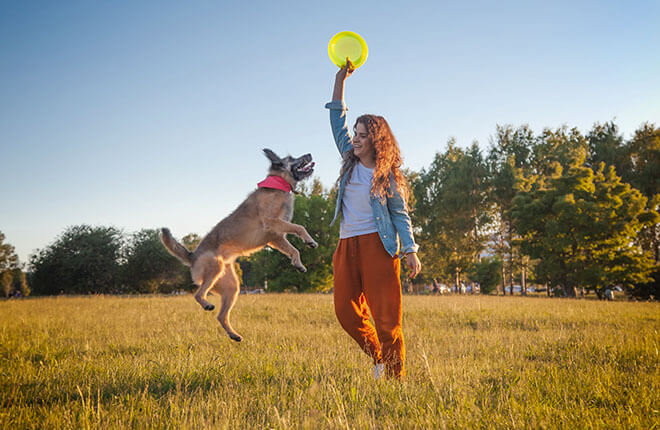Our cats and dogs give us so much joy. That joy is often best shared when we’re playing with them. Not only is play just all-around fun, but it’s also good for mental and physical health of both pet and owner. If you’re looking to add more fun to your pet’s day, read on for the best games to play with your dog or cat.

Games to Play with Your Dog
Catch Me If You Can
This is a great way to practice your dog’s come-when-called behavior while having a blast and getting your heart pumping. To play, grab some treats and have your dog in a fenced yard or on a long lead. You can even play indoors — anywhere there’s space to run.
Start by dropping a treat on the ground in front of you, and then immediately take off in a short sprint. When you stop, say your dog’s name and drop another treat at your feet. When they get to you, take off running again. It’s all about engaging your dog’s chase instinct and rewarding them for catching you. To take it to the next level, practice having your dog sit and stay at the previous stopping spot before giving them the command to come to you at the new spot.
Hide and Seek
Hide and seek is wonderful for children and dogs or for indoor exercise on rainy days. It works your dog’s problem-solving skills and relies on their nose to sniff out the hidden person or treats.
At first, make it easy for your dog to find you or their favorite interactive toy stuffed with treats. Let them watch you hide the treat or hide just around a corner or behind a door. Call their name and wait for them to find you or their treat. When they do, make a big deal out of how amazing they are. Give your dog hints as needed with a small whistle or tap of the foot to help them in their search. As they play this game more, start to make the hiding spots more difficult.
Flirt Pole
Flirt poles are like long fishing poles with a stuffed toy at the end of a line that your dog can chase and catch. They’re great for dog owners who can’t run around with their dog. A flirt pole taps into a dog’s desire to chase and catch prey and provides a perfect game to practice their drop-it cue.
Entice your dog to chase the lure at the end, keeping the lure close to the ground. Let them catch the toy, so they stay engaged and feel like they “won.” Ask them to drop it, and then start the chase again when they do. You might need to encourage a “drop it” with a treat at first, but the real reward will eventually be getting to chase again. Avoid dragging the toy to make your dog take sharp turns or jump up high to catch it. Flirt pole play should be low impact, so aim for large circles along the ground.
Games to Play with Your Cat
You may be thinking, “I don’t need to play with my cats. They play on their own.” But cats need playtime with you too. It’s important to understand how cats play and what they need from a play session.
The Prey Sequence
Cats have instinctual needs that, when met, mean a happy, healthy, thriving pet. One of those instinctual needs is the prey sequence. When cats hunt, they go through four steps: staring, stalking/chasing, pouncing, and the kill bite. They move back and forth through this sequence throughout a prey session.
Try 15 minutes of this play at least once a day. Use a wand toy — one of the only toys that takes your cat through all four steps. Move the lure around like prey. Let your cat watch, strategize, and catch the prey as it hides behind the couch, flies up the cat tree, flops on the floor. When you’re ready to end the session, let the prey slow down and give your cat a final kill bite, where they shake the prey in their mouth. Follow up with a yummy treat or meal to simulate eating their prey, and your kitty will be on their way to grooming and a nap. If your cat is a pro and makes multiple catches during the session, consider giving them a treat for each one. Remember, cats in the wild go after prey for a reason — a tasty reward!
Interactive Play with Toys
There’s no shortage of toys on the market for cats. It may take some experimentation to see what your cat likes and how you can play together.
Stuffed mice, balls, and spring toys are great to throw around for your cat to chase. You can also teach them to bring the toy back, adding some training to the game. If you have an athlete, tossing toys in the air gives them a chance to practice their jumping and catching skills. Add a cat tunnel, tossing the toy into the tunnel and watching your cat dive in after it. Giving your cat some variety will keep them physically and mentally engaged.
Hide and Seek
Many cats also love this childhood favorite. Grab some treats and go hide. Start simply, behind a door or around a corner. Call your cat. When they find you, give them a treat and lots of praise. You can make the game more challenging over time. This is a wonderful way to strengthen your connection with your cat.
Hunting Games
Cats love to hunt. You can engage that instinct in lots of ways.
“Under the covers” lets your cat pounce on hidden prey. Drape a blanket on the floor and drag a wand toy under it, like a snake slithering through the grass. Avoid doing this in your bed. Your cat may mistake nighttime movement for a play invitation.
Get your cat’s brain and nose working by hiding treats or part of their daily kibble around the home. Under furniture, back of the closet, behind pillows. You’ll be amazed how quickly they track it down. Food puzzles are another fun way to engage your cat’s mind with problem-solving.
A simple cardboard box with small holes cut in the sides becomes an instant hunting game. Toss in a few balls or furry mice for your cat to bat around and try to pull from the box. You can even add some brown packing paper and a little catnip for a digging party.
ZPC-01257R1

.jpg)

